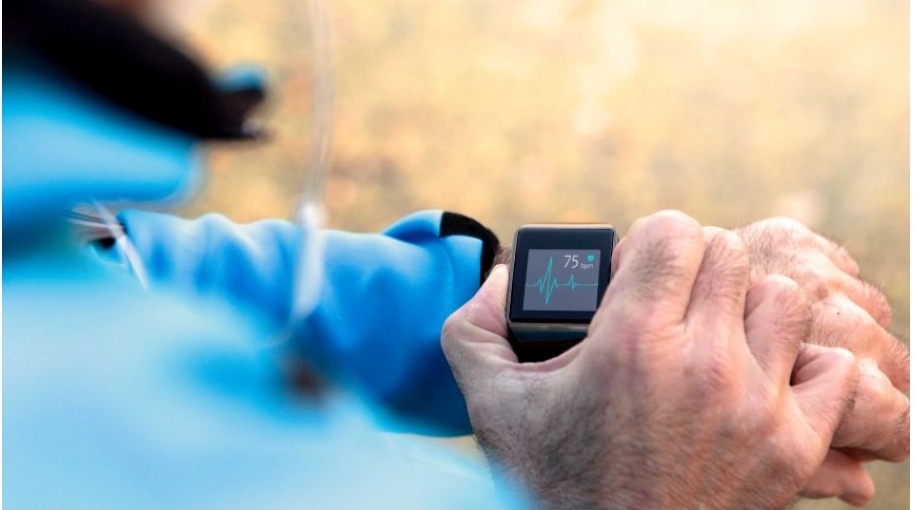Getting to the heart of it : Cardio fitness, your heart rate and what to aim for during exercise

By Olivia Willis
Dated : 03 Jan 2021 (IST)
Today, we’re more aware of our heart rate thanks to fitness trackers and smartwatches.(Getty Images: Nastasic)
It will beat around three billion times over your lifetime, without you even having to think about it.
Every day, your heart pumps blood through a system of blood vessels over 100,000 kilometres long, providing your body with the oxygen and nutrients it needs to function.
It’s nothing short of miraculous. But how fast (or slow) your heart beats depends on a few things, including your age, medical conditions, and overall fitness level.
Thanks to smartwatches and fitness trackers, you can now monitor your heart rate more easily, particularly during exercise.
But what constitutes a ‘normal’ heart rate? And is there much to gain from tracking it?
Understanding your resting heart rate
When it comes to your resting heart rate (the number of times your heart beats per minute while you are at rest) there is “no hard and fast rule about what’s normal” says Garry Jennings, cardiologist and chief medical advisor at the Heart Foundation.
“Whilst we might notionally say something around 70 is typical, some people have a much lower heart rate, and some people have a much higher heart rate … it varies between individuals,” Professor Jennings says.
Generally, for adults, the normal range for a resting heart rate is between 60 and 100 beats per minute.
“But if you’re healthy and well, and it falls outside those levels, that isn’t necessarily a problem in itself,” Professor Jennings says.
Athletes, for example, often have much lower resting heart rates — sometimes as low as 40 beats per minute. A lower resting heart usually indicates more efficient heart function and greater cardiovascular health.
“As you train more, and your heart gets more efficient, it’s able to pump better, and you don’t need as many heart beats to put out as much blood each minute,” Professor Jennings explains.
“If your heart is having trouble pumping, then it will pump at a faster rate to make up for that. So, it can be a sign of early disease in some people.”
Research has shown that higher resting heart rate is associated with an increased risk of cardiovascular disease (heart attack, stroke and heart failure) and early death.
However, if your resting heart rate sits towards the higher end of the scale, it’s not necessarily a cause for concern.
“I think people tend to over-diagnose themselves on the basis of their heart rate. It’s normal for it to vary, and what’s normal for me will be different to what’s normal for you,” Professor Jennings says.
What speeds it up (and slows it down)
There are a number of factors that can influence your heart rate, both in the short and long term.
When you exercise, for example, your heart rate speeds up in order to pump more blood around your body.
According to the Heart Foundation: “Your body contains about five litres of blood, all of which passes through your heart every minute or so. However, when necessary, such as during exercise, your heart can pump up to four times that amount per minute”.
In the long term, maintaining good physical fitness will help to lower your resting heart rate by improving your heart’s ability to pump blood around the body more efficiently.
Day to day, things like caffeinated beverages, such as coffee and energy drinks, will increase your heart rate by blocking the chemical in your brain that causes drowsiness.

Caffeine induces alertness and increased energy as a result of its interactions with adenosine receptors in the brain.(Pixabay)
Similarly, when you feel stressed or excited, your body’s sympathetic nervous system (which triggers the fight or flight response) is activated, causing your heart rate to speed up.
In contrast, when your body is relaxed, the parasympathetic nervous system (sometimes called the “rest and digest” system) is activated. This system conserves energy as it slows your heart rate.
There are also some medications that can have an effect on your heart rate, including beta blockers (tablets that reduce blood pressure), antidepressants, and some over-the-counter cold and flu medicines.
Other underlying and potentially more serious complications that may affect your heart rate include infection (particularly when spread into the bloodstream), thyroid disease, heart arrhythmias (a disturbed rhythm of your heart beat), and other heart problems.
Making sense of your maximum
To work out your maximum heart rate (the upper limit of what your heart can handle during physical activity), subtract your age from 220.
(For example, if you’re 35, 220 minus 35 equals 185. Your maximum heart rate should be around 185.)
Using your maximum heart rate, you can work out the intensity of the exercise you’re doing and how hard you are working out.
Moderate intensity exercise will raise your heart rate to about 55-70 per cent of your maximum heart rate, while rigorous or high intensity exercise will raise your heart rate to about 70-85 per cent it.
The Australian Exercise Guidelines recommend people do at least 30 minutes of “moderate intensity” exercise five times a week (150 minutes in total), or 75 minutes of “vigorous intensity” exercise a week.

Swimming, brisk walking, and jogging are all exercises that can be done at moderate to high intensity.
The “220 minus your age” rule can help you to set a rough target heart rate for each time you work out.
It is, however, only a rough guide because everyone’s heart rate varies, says Professor Jennings.
“It’s a guide, but people shouldn’t be worried if they can’t get to that level.”
Another way to track the intensity of your workout is to simply focus on how your body is responding.
“Your own perception of exertion is a pretty good guide,” says Professor Jennings.
“At about 50-60 per cent of your maximum heart rate, you’ll be feeling some discomfort, you’ll be breathing heavily, but you’ll still be able to carry out a conversation.
“At 70-80 percent of your maximum — so high intensity — you couldn’t say more than a few words without pausing for breath.”
“Anything above that is very high and fairly unsustainable,” says Sam Rooney, accredited exercise physiologist.
Mr Rooney says assessing the intensity of your workout (or calculating your heart rate) isn’t always necessary to improving your fitness.
“The average person getting into fitness tends to overcomplicate things,” he says.
“If someone is simply wanting to hit their 150 minutes per week, they shouldn’t worry too much about their heart rate. It’s more about just getting 150 minutes of movement in.”
How it changes with age
As you get older, your maximum heart rate will start to decline.
“Someone who is 70 might have a maximum heart rate of 130 or so, whereas someone who is young, fit and active in their 20s might be able to get to 200,” Professor Jennings says.
“It’s partly because as you get older, your muscles can’t get you to the same level of activity … and it’s partly because the heart itself doesn’t function the same with ageing.
“Like the rest of the body, it gets a bit stiffer, and therefore you don’t get to the same level of exercise or heart rate.”
Mr Rooney says for most people, instead of focusing on their heart rate, the important thing is to mix up their exercise regime so that it feels “fresh, interesting, and so they don’t get bored”.
“If you’re someone who wants to exercise and do something that’s beneficial, it’s more important that you enjoy what you’re doing.”
Health in your inbox
Get the latest health news and information from across the ABC.




